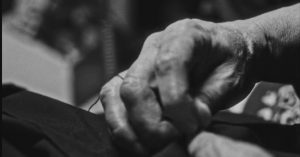If some believe that the world was created in seven days, the two directors of the docufiction, The Los Restos del Pasar (Trail Left by Time), Luis Muñoz Cubillo alias “Soto” and Alfredo Picazo, recreate the memories of seven days in childhood that laid the foundations for the narrator’s setting of the movie. In this excellent docufiction, shot in black and white, we witness the unfolding of everyday life in a village in Cordoba during the Easter celebrations. Antonio, a lonely and curious child, takes us into all corners of his surroundings at his own height, and makes us see the creative process of all kinds: painting, sewing, cooking, singing, and religious belief.

Plunging into the world of remembrance
The film begins with the scene where a man hangs a blank canvas on the wall. The hands we see are those of Paco, an elderly painter, who will teach Antonio not only to paint, but also to observe and to understand life as a transitional stay. Then starts the play of shadow and light, inside versus outside, characters versus the setting, which itself has an enormous storytelling potential. One of the most relevant examples of it is undoubtedly the demonstration of the interior of Paco’s house. The position of the camera reveals a very telling whole, ranging from the stairs and objects decorating the walls, to Paco’s old and suffering body. Every object becomes an artistic element.
The careful preparation for a religious procession is interspersed with scenes of children’s carefree games. Scenes which recall certain scenes from the films by Abbas Kiarostami and Amir Naderi, two Iranian directors who, after Italian neorealism, brought back or updated in their films the frequent portrayal of children. This parallelism will be followed throughout the film.
Hands as a tool of creation and transmission
The child’s look at the hands of the women sewing outfits for the procession continues as other hands, all busy serving life, are depicted. From sewing, the hands move on to washing, making pastries, and, little by little, making drums that accompany the Eucharistic procession. This is how the link between earthly life and religious beliefs gets established. The bloody hand of the statue of Jesus, with his head bearing marks of torture, invites the inhabitants and spectators to renew and rediscover their belief by walking alongside the procession, marking spectators of all ages. Children and adults compose the Roman army and some of this young extras look like martyr’s children in Muslim processions.

How can the juxtaposition of images generate reflections?
The climax of the procession, whether directors chose it intentionally or not, is the moment when the statue of Jesus stops in front of a window with bars, behind which are a man and a child. This scene lasts enough time for Jesus’s bloody hand to give a blessing—though the gesture is reassuring, the scene could also be interpreted as portraying human beings imprisoned by religious beliefs (with bars as a symbol).
Antonio’s smile when he enters a house and rushes upstairs to get a better view of the wooden donkey on which Jesus is sitting is different from the moment when, perched on a tree. He watches the donkey grazing under Paco’s graze while he is drawing it: the first transmits incredulity, and the second wonder. In fact, we want to believe that the child is skeptical about the wooden inanimate statue of an idol. At one point he says as the procession advances, “They are sad and I know why.”
The choice of the empty space, in which a female singer launches her elegiac song to give the signal for the departure of the procession, is disturbingly effective. Does it represent the Madonna who accompanies her son to the crucifixion? The portrayal of a woman sing contrasts starkly with the ban by religious clerics, since the advent of the Islamic Republic in 1979, on women singing solo in Iran.
The subtle transition from black to color and choice of light and shadow
The subtlety and accuracy with which the transition from black and white to color occurs may be one of the film’s main strengths. For instance, when Paco paints, a red dot appears on the palette and then, little by little, everything turns to color, without the spectator immediately perceiving it.

The two directors succeed in their approach to the play of shadow and light, whether it be nocturnal or during daytime, both indoors and outdoors. In fact, the dark interior scenes give the impression of Chinese shadow theater. We don’t see any faces or their expressions, but the actions of the characters are enough to move the story forward. It also creates more tension and helps to enrich the film without adding dialogues, which are also proportionately few. For this reason, whenever there is dialogue, it serves the film with insight and gives it a human flavor. The lovely dialogue on guardian angels between two children, before falling asleep, is an example. It should be noted that old Antonio is recalling, in voiceover, the memories of his childhood during Easter holidays.
Curiously, despite the fact that the two directors are very young (both filmmakers were born in Córdoba in 2000), they become spokespersons for a man in the twilight of his life. They delicately deal with the themes of creation in all its aspects and with religious beliefs, and depict the boundaries of life and its meaning as death approaches. This poignant portrayal is made possible thanks to a subtle transition from black to color, a striking soundtrack, a mixture of light and shadow, good framing and camerawork. I hope, and it seems so, that we will hear from these two directors in the future. Remember their names.
Shahla NAHID
Edited by Ela Bittencourt
© FIPRESCI 2023
